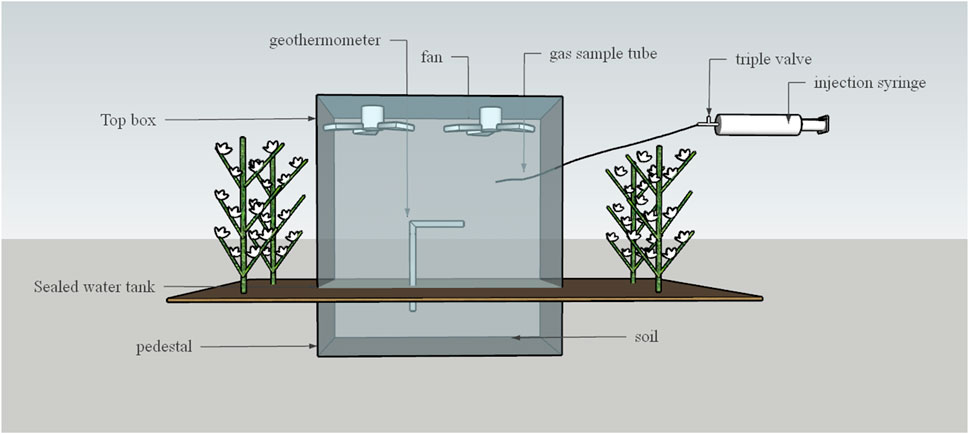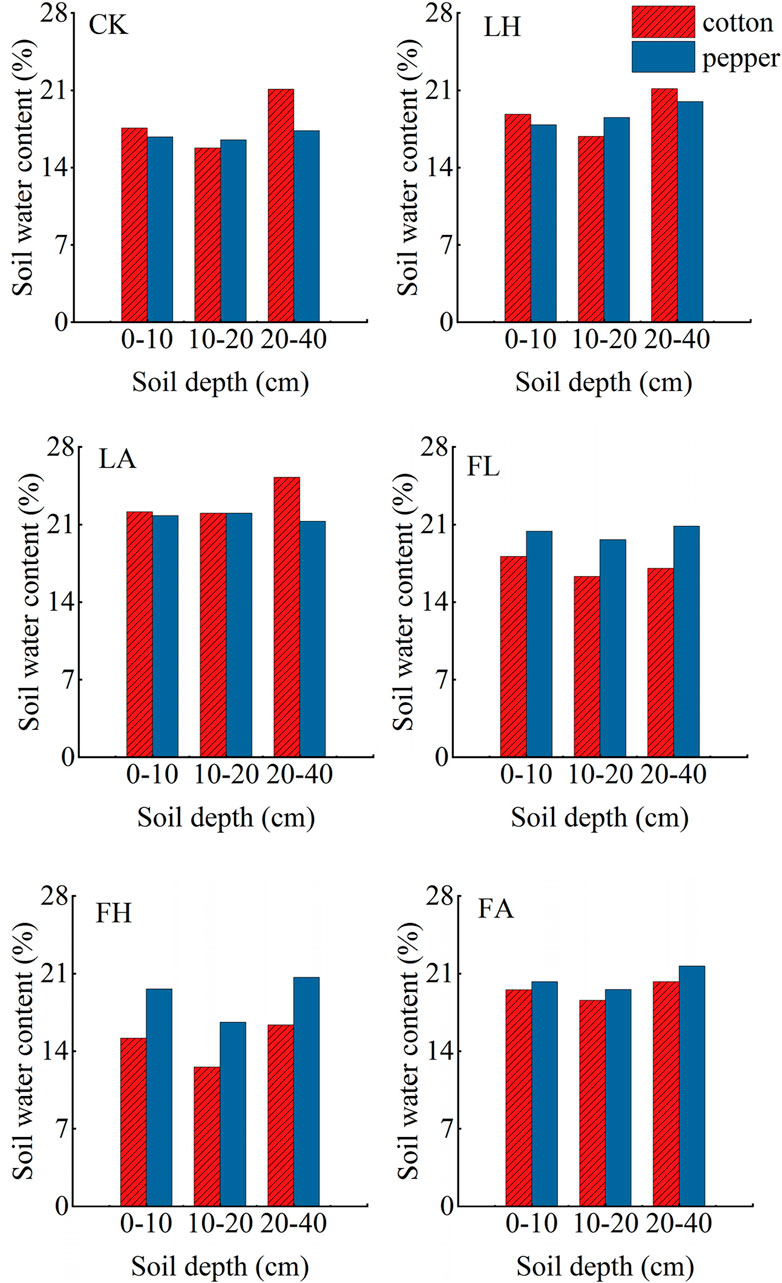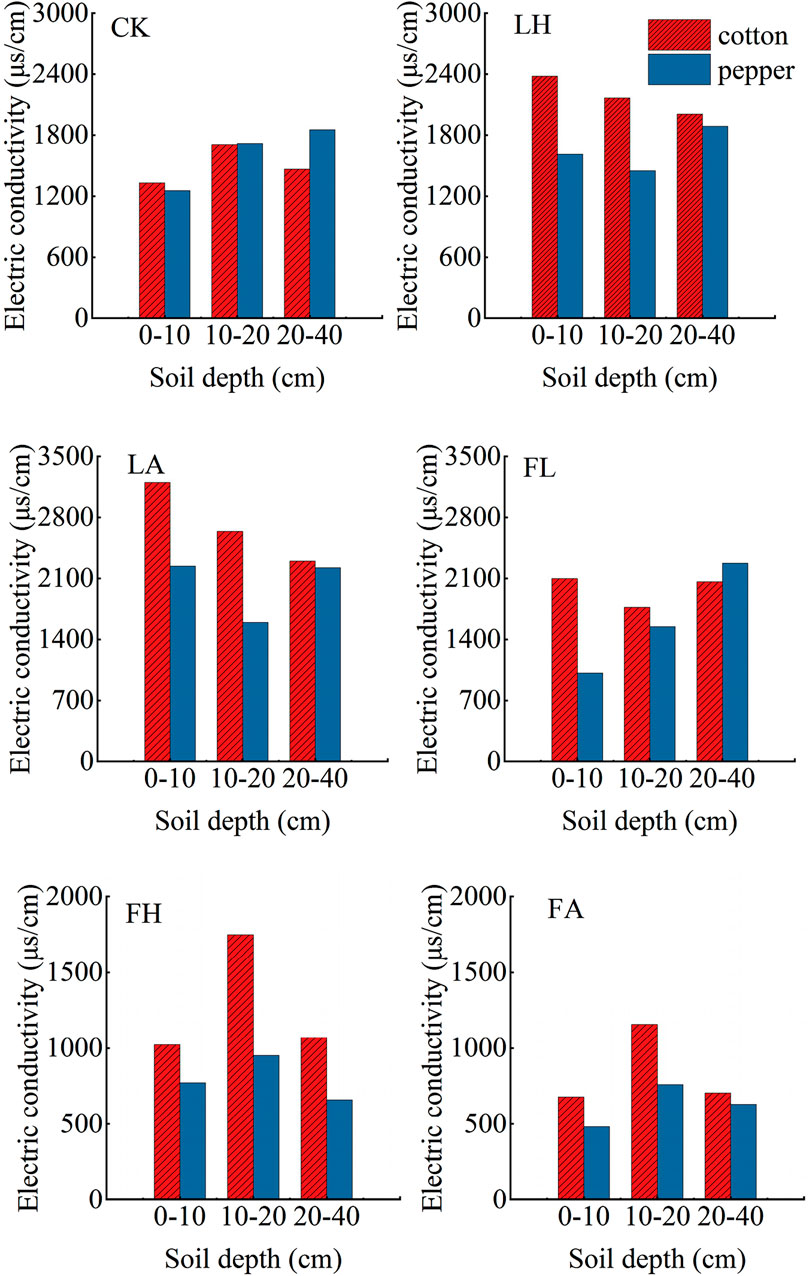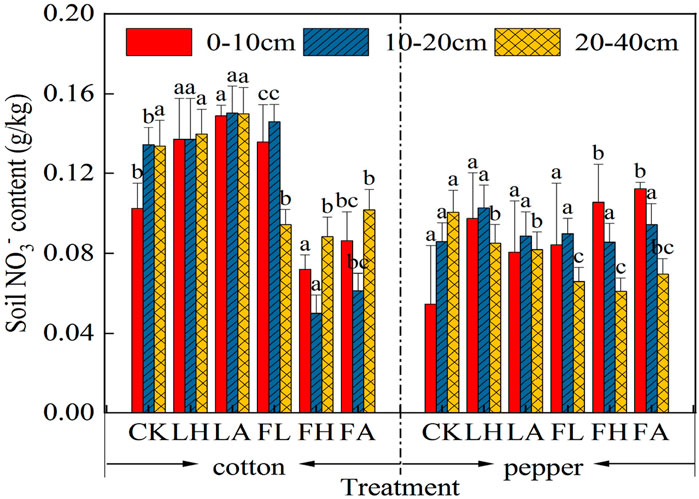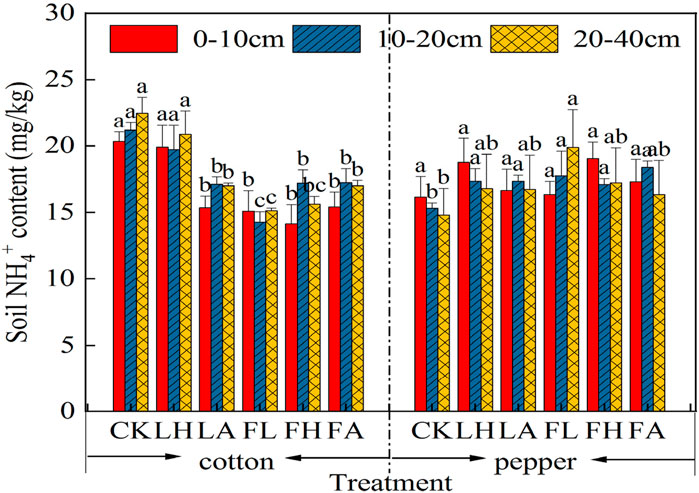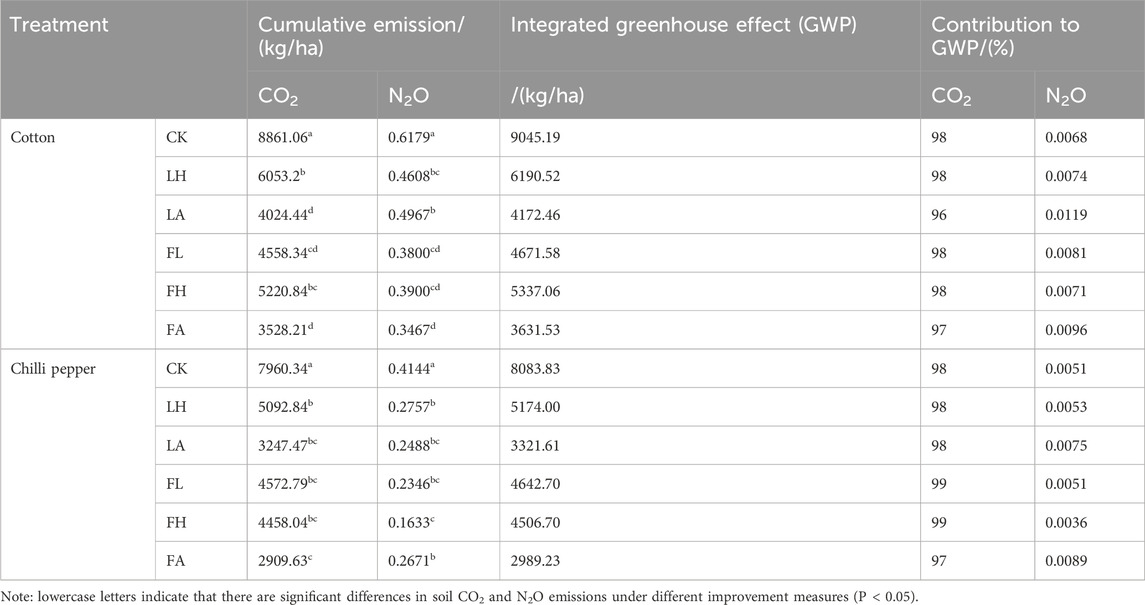- College of Hydraulic and Architectural Engineering, Tarim University, Alaer, China
As two important greenhouse gases in the atmosphere, CO2 and N2O have been paid much attention to their environmental effects. As a large agricultural and population country in the world, agricultural soil is an important source of greenhouse gas emissions. In recent years, unreasonable agricultural measures will make the soil structure deteriorate and lead to the increase of saline-alkali cultivated land area. Therefore, the comprehensive utilization of saline-alkali land has practical significance for agricultural production and ecological environment safety in our country. In this study, the 11th Regiment of Alar City of the First Division of Xinjiang carried out field tests on saline-alkali cultivated land, and improved the saline-alkali cultivated land with desulfurized gypsum and aeolian sand. Six treatments were set up (blank treatment (CK) desulfurized gypsum 15 t/ha (LH), desulfurized gypsum 30 t/ha (LA), desulfurized gypsum 15 t/hamixed application (FL), Aeolian sand 15 t/ha (FH), and Aeolian sand 30 t/ha (FA)). The effects of different treatments on CO2 and N2O emission fluxes in cotton-pepper soil were observed. The results show that: (1) In the growth stage of cotton-pepper, compared with CK, soil moisture increased, and soil ammonium nitrogen decreased; The conductivity increases with the increase of desulphurized gypsum and the decrease of aeolian sand. The results showed that LA treatment had the best water retention effect and FA treatment had the best salt reduction effect. (2) Compared with CK, the cumulative CO2 emission fluxes of cotton soil under different treatments were CK > LH > FL > FH > LA > FA treatment, and those of pepper soil were CK > FL > LH > FH > FA > LA treatment. Among them, the inhibition effect of cumulative soil CO2 emission under LA and FA treatment reached a significant level. (3) Compared with CK, the cumulative N2O emission fluxes of LH, LA, FL, FH and FA treated soil in cotton field were CK > LA > LH > FH > FL > FA, and that of pepper soil was CK > FA > LH > LA > FL > FH. Among them, the inhibition effect of aeolian sand (FA and FH) on soil N2O cumulative emission reached a significant level. (4) Compared with CK, LH, LA, FL, FH and FA treatments reduced the comprehensive greenhouse effect of cotton field and pepper crops by inhibiting soil CO2 emission fluxes, among which FA treatment had the lowest comprehensive greenhouse effect. Therefore, the effects of different treatments on physicochemical properties and gas emissions of saline-alkali soil were comprehensively analyzed, and FA treatment had the best effect on inhibiting CO2 and N2O emissions and improving soil physicochemical properties.
1 Introduction
Climate change is one of the serious challenges facing mankind, and with the increase in global temperature, the issue of climate change has become the biggest risk facing the whole world at present, in which greenhouse gas emissions caused by human activities are the main cause of climate change. As two important greenhouse gases, CO2 and N2O in the atmosphere contribute 80% to the greenhouse effect (Kiehl and Trenbeth, 1997). As a large agricultural and population country in the world, the greenhouse gas (GHG) emissions associated with agricultural activities in China are about 828 million tons of carbon dioxide equivalent (CO2-eq), which is about 7.9% of the total global GHG emissions, and N2O also contributes more than 300 million tons of CO2-eq (Zhang et al., 2023). China has about 3.6 × 107 ha of saline-alkali land, which has 4.88% of the available land area in the country (Li et al., 2014). Therefore, the study of GHG emissions from saline soils in agricultural fields is a topic that needs to be focused on.
The low nutrient content in saline soils, salinization of saline soils severely inhibits the accumulation of organic matter in saline soils, as well as poor soil structure and high soil salinity (Chen, 2023), which leads to reduced crop yields and seriously affects the development of agriculture. Among them, the application of soil conditioners can effectively improve saline and alkaline soils. As an important safeguard for agricultural production and one of the important measures to improve saline soils, different soil amendments can improve soil physical and chemical properties and soil structure while at the same time affecting GHG emissions. In agroecosystems, GHG emissions, soil physicochemical properties and crop yields can vary significantly depending on the amount and method of application (Shao et al., 2022). Zhang et al. (2019) showed that gypsum has the best effect on inhibiting greenhouse gas emissions. Li (2023); Wang (2020) and Xiang (2018) reported that soil greenhouse gas emissions were significantly suppressed with the application of FGD gypsum Jiang et al. (2023). The study indicated that as the amount of desulphurized gypsum applied increased, the rate of decrease in the percentage of sodium exchanged and the rate of increase in crop yield showed an increasing and then decreasing trend, while the rate of increase in the electrical conductivity of the soil leachate showed an increasing trend. As FGD gypsum itself is a kind of salt, long-term application or mismanagement may lead to an increase in the total salt content of the soil (Huang et al., 2011). Therefore, different alkaline soil improvement also requires strict control of FGD gypsum application. Sand mixing can improve soil structure, increase the effective porosity and permeability of soil (Zhang et al., 2019), accelerate water infiltration, increase water content and reduce soil salinity. Therefore, in this study, a field experiment was conducted to monitor the response of CO2 and N2O emissions from cotton-chilli soils in the extreme arid zone to different amounts of FGD and FGD gypsum applied, with the aim of selecting the most beneficial soil amendment for saline-alkaline soils by determining the CO2 and N2O emissions and the main influencing factors under different cropping modes, with a view to providing theoretical support for the sustainable development of agriculture in the region.
2 Materials and methods
2.1 Overview of the study area
The experiment was carried out in 2023 in the 11th regiment of Alar City, the first division of Xinjiang, the experimental field is located in the south of Tianshan Mountain, adjacent to the northern edge of the Taklamakan Desert, geographic location 40.38° N, 81.37° E. The land belongs to the extreme continental climate of the warm zone, the average temperature during the test period is 33°C, the average annual rainfall is 40.1–82.5 mm, and the basic physical and chemical properties of the soil are shown in Table 1.
2.2 Experimental design
In this study, plots without the application of amendments were used as controls, and FGD gypsum 15 t/ha (LH), FGD gypsum 30 t/ha (LA), FGD gypsum 15 t/ha and aeolian sand 15 t/ha mixed (FL), aeolian sand 15 t/ha (FH), aeolian sand 30 t/ha (FA), and the control (without the application of the amendment CK), with a total of six treatments, each with three replicates and a plot area of 18 m × 3.3 m. Before sowing the crops, the plots containing FGD gypsum (from Alar City Lantian Thermal Co., Ltd.) and aeolian sand (from the 11th Regiment of Alar City, the First Division of Xinjiang - the Gate of Taklamakan Desert) were rototilled using agricultural machinery, so that the soil conditioner in the single- and mixed-application treatments was uniformly distributed in the 0–30 cm soil layer.
2.3 The test crops were cotton and chilli pepper
They were planted with under-mulched drip irrigation, with a film width of 200 cm, and drip irrigation tapes were laid in 6 rows of 1 film and 3 tubes, with a wide spacing of 60 cm, a narrow spacing of 30 cm, and a plant spacing of 20 cm; the seeds were sown on 27th April 2023, and the harvest took place on 8th October 2023, and the planting of cotton and chilli was carried out in the same way. Diamine phosphate (220 kg/ha) and urea (60 kg/ha) were applied as the base fertilizer before sowing, and urea and compound fertilizer were added at the bud stage, bolling stage and fluffing stage of cotton. A total of 10 times of irrigation throughout the reproductive period, a single irrigation rate of 360 m3/ha Greenhouse gas sample collection and analysis.
2.3.1 Greenhouse gas emission flux capture
Soil CO2 and N2O gas emissions were collected continuously everyday before and after irrigation during the cotton bolling stage, and the gases were collected in situ using the static dark box method. The static chamber consisted of a top box (0.5 m × 0.5 m × 0.5 m) and a base (0.5 m × 0.5 m × 1.5 m). A thermometer slot is provided in the box to observe the temperature change in the box during sampling. A foam plate with a thickness of 2 cm is arranged outside the box to prevent the temperature in the box from rising too fast during sampling. The base was buried in the soil of each test plot in the field, with the soil surface flush with the top of the base, and the top of the base was equipped with a 5-cm-thick groove for placing the top box, which was filled with water and sealed with water to prevent the exchange of air between inside and outside of the sampling box when collecting gases (Figure 1). The collection time was from 11:00 to 14:00 p.m., and the gas was collected every 15 min for 45 min after hooding the box, and the collected gas was transferred to a 100 mL gas collection bag with a 50 mL syringe (Wei et al., 2021). After gas collection, the collected samples were brought back to the laboratory on the same day for analysis, and a gas chromatograph was used to determine the gas concentration in the gas sampling bag.
2.3.2 Determination of greenhouse gas emission fluxes
(1) The GHG analyses were carried out using a gas chromatograph to determine the CO2 and N2O concentrations in the gas sampling bags. The gas emission formula is (Guo et al., 2022):
where F represents the emission flux of CO2 and N2O (mg/(m2·h)), ρ denotes the density of the gas in the standard state (g/L), h is the height of the box (m), T is the average temperature inside the box (°C); Δc is the gas concentration difference, Δt is the time difference (h), and Δc/Δt is the emission rate of CO2 and N2O gas concentrations during the collection time, which was calculated according to the linear regression equation.
(2) The cumulative emission fluxes of the greenhouse gases CO2 and N2O were calculated as follows (Guo et al., 2022):
where M is the cumulative emission flux of soil CO2 and N2O (kg/ha), F is the emission flux of soil CO2 and N2O (mg/(m2·h)), i is the number of sampling times, and t is the sampling time (d).
(3) On a 100-year scale, the warming potential effect of N2O is 298 times greater than that of CO2, the global warming potential (GWP) effects of the greenhouse gases CO2 and N2O are calculated as follows (Wang et al., 2019):
where GWP is the potential effect of greenhouse gas emissions from cotton fields on global warming (kg/ha),
2.4 Testing of soil indicators
Soil water content: the soil was taken at 0–60 cm using a tube soil extractor at depths of 0–10 cm, 10–20 cm, 20–40 cm and 40–60 cm, respectively, and the retrieved soil samples were placed in an aluminum box in a constant temperature oven at 105°C for 24 h, and weighed to obtain the soil water content. The soil electrical conductivity was determined using a 308-type conductivity meter to determine the conductivity value (EC1:5) of the soil extract samples. Soil ammonium nitrogen and nitrate nitrogen contents were determined using a Smartchem fully automatic intermittent analyzer to determine the ammonium nitrogen and nitrate nitrogen contents.
2.5 Statistical analyses
Excel 2023 was used for experimental data processing and correlation analysis in SPSS 26.0 software was used to deal with the relationship between soil CO2 and N2O emission fluxes as well as soil physicochemical properties of the two crops, cotton-pepper, under different soil improvement measures. Origin 2021 software was used for graphing.
3 Results and analyses
3.1 Effect of application of FGD gypsum and aeolian sand to different crops on soil physicochemical properties
3.1.1 Effect of application of desulphurized gypsum and aeolian sand to different crops on soil moisture
Soil moisture is an important component of soil and is the main source of water absorption for plants. Suitable soil moisture is conducive to the reproduction and metabolism of soil microorganisms, the decomposition of soil organic matter and the release of nutrients, thus promoting plant growth. The effect of growing two crops, cotton and chilli pepper, under different amounts of FGD gypsum and aeolian sand on soil moisture at the 0–40 cm soil horizon is shown in Figure 2. Under the CK treatment, the soil moisture of cotton-chilli at the 0–10 cm and 20–40 cm soil horizons was increased by 4.88% and 21.42% compared to that of chilli. In 10–20 cm soil layer cotton soil moisture decreased by 4.47% compared to chilli. Under LH treatment, cotton soil moisture increased by 5.32% and 5.84% in 0–10 cm and 20–40 cm soil layers than chilli. In 10–20 cm soil layer cotton soil moisture decreased by 9.31% compared to chilli. Under LA treatment, cotton soil moisture in 10–20 cm soil layers was same as chilli and in 0–10 cm and 20–40 cm soil layer chilli soil moisture was 1.53% and 18.77% less than cotton. Under FL, FH and FA treatments, cotton soil moisture in the 0–10 cm, 10–20 cm and 20–40 cm soil layers was reduced by 11.03%–18.09%, 20.42%–24.46% and 3.54%–6.47%, respectively, compared to chilli.
In summary, the soil moisture of cotton field-pepper increased gradually with the increase of FGD gypsum and sand application. Under FGD gypsum treatments (LH and LA), cotton field soil moisture was greater than chilli soil moisture in the 0–10 cm and 20–40 cm soil horizons, and cotton field soil moisture was less than chilli soil moisture in the 10–20 cm soil horizons. Cotton soil moisture was less than chilli soil moisture in the 0–10 cm, 10–20 cm and 20–40 cm soil horizons under aeolian sand treatments (FL, FH and FA).
3.1.2 Effect of application of desulphurized gypsum and aeolian sand to different crops on soil conductivity
The effect of growing two crops, cotton and chilli pepper, under different amounts of FGD gypsum and aeolian sand on soil conductivity at 0–40 cm soil layer is shown in Figure 3. It can be seen from the figure that soil conductivity of cotton-soil at 0–10 cm soil layer increased by 5.98% in comparison to that of chilli under CK treatment. At 10–20 cm and 20–40 cm soil layers cotton soil conductivity decreased by 6.4% and 20.83% than chilli, respectively. Under LH and LA treatments, cotton soil conductivity increased by 42.88%–47.55%, 49.21%–65.52%, and 3.37%–6.36% in 0–10 cm, 10–20 cm and 20–40 cm soil layers, respectively, compared to chilli. Under FL treatment, soil conductivity varied from 16.34% to 18.15% in cotton and 19.64%–20.5% in chilli. In 0–10 cm soil layer chilli soil conductivity was reduced by 51.96% compared to cotton. In 10–20 cm and 20–40 cm soil layers cotton soil conductivity was reduced by 37.64% and 6.86% than chilli, respectively. Similarly, under FH and FA treatments, soil conductivity of cotton increased by 24.44%–45.54% and 10.78%–34.31% in 0–10 cm, 10–20 cm and 20–40 cm soil layers, respectively, compared to that of chilli.
In summary, the soil conductivity gradually increased with the increase of FGD gypsum application, and the soil conductivity gradually decreased with the increase of sand application. It showed that the aeolian sand treatment had a salt-reducing effect, among which the aeolian sand 30 t/ha (FA) treatment had the best salt-reducing effect. In the 0–10 cm, 10–20 cm and 20–40 cm soil layers, the soil conductivity of cotton field was greater than that of chilli pepper in LH, LA, FH and FA treatments.
3.1.3 Effect of application of desulphurized gypsum and aeolian sand on soil nitrate nitrogen in different crops
Soil is an important source of nutrients for plants, and nitrate nitrogen and ammonium nitrogen are the two inorganic forms of nitrogen in soil that are easily absorbed and utilized by plants (Liu et al., 2023; Tong et al., 2024). The effect of planting two crops, cotton and chilli pepper, under different amounts of FGD gypsum and sand, on soil nitrate nitrogen at 0–40 cm is shown in Figure 4. After different amounts of FGD gypsum and sand were applied to the soil, the nitrate nitrogen content of the soil under each treatment of cotton was significantly different at 0–10, 10–20 and 20–40 cm. Compared with the CK treatment, the nitrate nitrogen content in the 0–10 cm soil layer was increased in the LH, LA and FL treatments, with growth rates of 33.79%, 45.51%, 32.49%, respectively. The soil nitrate nitrogen content in the 10–20 cm soil layer showed an increasing trend with the increase in the amount of FGD gypsum and sand application, and the nitrate nitrogen content in the LH, LA and FL treatments was increased, with growth rates of 2.01%, 11.94% and 8.71%, respectively. At 20–40 cm, LA and LH treatments increased nitrate nitrogen content with growth rates of 4.54% and 12.28%.
There were significant differences in soil nitrate nitrogen content at 0–10, 10–20 and 20–40 cm under each treatment of chilli. Compared with the CK treatment, the nitrate nitrogen content at 0–10 cm and 10–20 cm soil layer showed an increasing trend with the decrease of FGD gypsum dosage and the increase of aeolian sand dosage, with the growth rate of 47.74%–93.22% and 0.35%–19.7%, respectively. At 20–40 cm, soil nitrate-nitrogen content showed an increasing trend with the decrease of FGD gypsum use and the increase of aeolian sand use, and the nitrate-nitrogen content of all treatments decreased compared with that of CK, with the rates of decrease of 15.37%, 18.65%, 34.49%, 39.26% and 30.75%, respectively.
3.1.4 Effect of application of desulphurized gypsum and aeolian sand on soil ammonium nitrogen in different crops
The effects of growing cotton and chilli crops with different amounts of FGD gypsum and sand were shown in Figure 5. Soil ammonium nitrogen content in the 0–40 cm soil layer was significantly different in the 0–10, 10–20, 20–40 and 40–60 cm soil layers in cotton treatments with different amounts of FGD gypsum and sand applied to the soil. The ammonium nitrogen content was reduced at 0–10 cm, 10–20 cm and 20–40 cm soil layers by 2.08%–30.5%, 6.94%–32.75% and 4.24%–37.31%, respectively, as compared to the CK treatment.
Soil ammonium nitrogen content of chilli peppers decreased with the increase of FGD gypsum and aeolian sand application in 0–10 cm soil layer, and showed an increasing trend with the increase of FGD gypsum and aeolian sand application at 10–20 cm and 20–40 cm soil layer. Compared with the CK treatment, all treatments increased the ammonium nitrogen content at 10–20 cm and 20–40 cm, with growth rates ranging from 11.65% to 20.03%, 4.2% to 22.17%, respectively.
3.2 Impact of FGD gypsum and aeolian sand application on soil GHG emissions for different crops
3.2.1 Effect of application of desulphurized gypsum and aeolian sand on CO2 emission fluxes from cotton-pepper soils
Soil CO2 emission is the process by which soil emits CO2 due to metabolism, of which plant root respiration and soil microbial respiration are the most important components (Shi et al., 2010). The poor physicochemical properties of alkaline soils lead to a clayey texture and low water infiltration coefficient (Yin, 2011). Therefore, the application of different amendments to the soil had a positive effect on improving the soil structure and soil environment, which in turn altered the microbial activity in the soil and the physiological activity of the crop root system, thereby affecting the CO2 emission fluxes. The effects of different application rates of FGD gypsum and aeolian sand on CO2 emission fluxes of cotton-pepper soil are shown in Figures 6A, B. The soil CO2 emission fluxes of the two crops showed similar trends, with peaks on the first day after irrigation and fertilizer application, followed by a gradual decline. The average daily soil CO2 emission fluxes of LH, LA, FL, FH and FA treatments in cotton field ranged from 211.23 to 2319.79 mg/(m2 h), and the average daily CO2 emission fluxes of the treatments were reduced by 32.49%, 56.93%, 51.47%, 41.14%, and 65.55%, respectively, when compared with that of control CK. The average daily CO2 emission fluxes of soil in chilli LH, LA, FL, FH and FA treatments ranged from 186.95 to 2499.71 mg/(m2 h), respectively, and were reduced by 31.47%, 60.83%, 48.10%, 46.80%, and 66.01%, respectively, compared with the control CK.
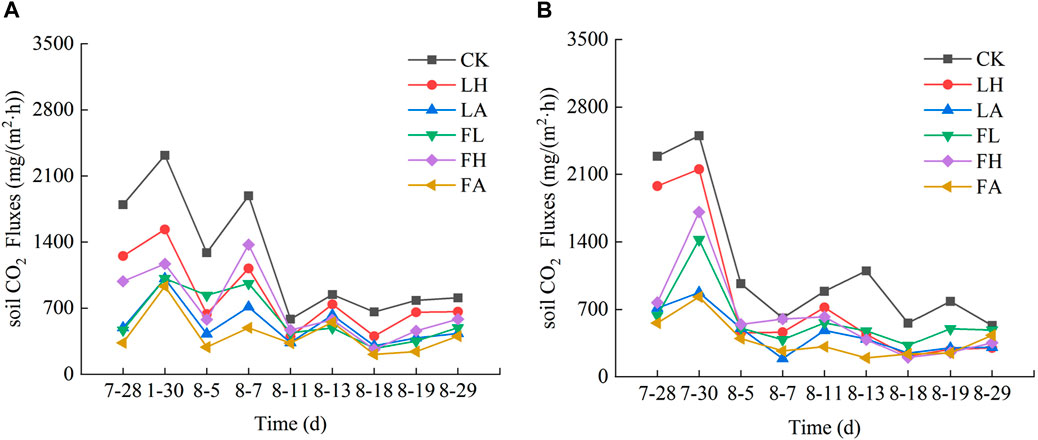
Figure 6. (A) Changes in soil CO2 emission fluxes of cotton under different treatments (Note: a is soil CO2 emission flux from cotton fields). (B) Changes in soil CO2 emission fluxes of pepper under different treatments (Note: b is soil CO2 emission flux from chilli peppers).
This shows that both cotton and chilli crops significantly suppressed CO2 emissions in all treatments under different application rates of FGD and sand, indicating that both FGD and sand amendments have the property of suppressing CO2 emissions, and soil CO2 emission fluxes decreased with the increase of FGD and sand applications, and the overall performances of soil CO2 emission fluxes in all treatments of cotton-chilli were all The overall performance of soil CO2 emission fluxes of cotton field-pepper treatments was CK > LH > FH > FL > LA > FA in order.
3.2.2 Effect of application of desulphurized gypsum and aeolian sand on cumulative emission fluxes of CO2 from cotton-pepper soils
Cumulative soil CO2 emission fluxes were calculated for cotton-pepper at fertility stage. The following results were obtained from Figure 7. The cumulative CO2 emission fluxes of the cotton treatments ranged from 3528.21 to 8861.06 kg/ha. Compared with the CK treatment, the LH, LA, FL, FH and FA treatments decreased by 31.69%, 54.58%, 48.56%, 41.08% and 60.18%, respectively. The cumulative CO2 emission fluxes of chilli peppers ranged from 2909.63 to 7960.34 kg/ha. It was reduced by 36.02%, 59.2%, 42.56%, 44%, and 63.45% in LH, LA, FL, FH, and FA treatments, respectively, compared to CK treatment.
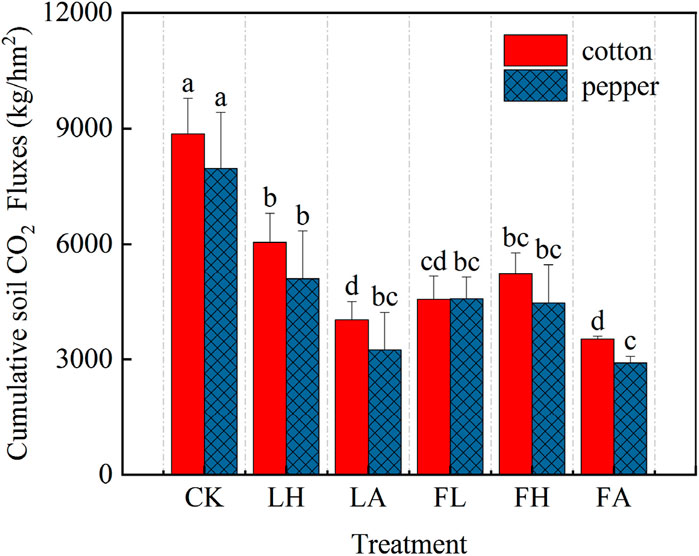
Figure 7. Changes in soil CO2 emission fluxes of pepper under different treatments (Note: b is soil CO2 emission flux from chilli peppers).
Comparison of cumulative CO2 emission fluxes of cotton and pepper among different treatments showed that the cumulative soil emission fluxes of cotton and pepper were CK > LH > FH > FL > LA > FA, and the cumulative soil CO2 emission fluxes of all treatments in cotton field were higher than those of pepper. Under the conditions of different amounts of FGD gypsum and sand accumulation, the cumulative soil CO2 emission fluxes of chilli treatments were 10.16%, 15.87%, 19.31%, −0.32%, 14.61% and 17.53% lower than those of cotton field, respectively.
In summary, the cumulative soil CO2 emission fluxes of the two crops, cotton and chilli pepper, gradually decreased with the increase of FGD gypsum and fenugreek application, which was mainly due to the fact that FGD gypsum and fenugreek were rich in trace elements and ions that inhibited the microbial activity of the soil, and affected the composition and content of organic matter in the soil, thus affecting the respiration of soil microorganisms and the decomposition of organic matter by soil microorganisms to reduce soil CO2 emission. By improving the physical and chemical properties of the soil and activating the soil nutrients or affecting the ratio of soil carbon and nitrogen, the composition and content of organic matter in the soil directly or indirectly affects the respiration of soil microorganisms and the decomposition of organic matter by soil microorganisms to reduce the emission of soil CO2.
3.2.3 Effect of application of desulphurized gypsum and aeolian sand on N2O emissions from cotton-pepper soils
Soil N2O is produced by nitrification and denitrification processes under aerobic and anaerobic conditions, and this process is closely related to crop root growth. The effects of different application rates of FGD gypsum and windblown sand on N2O emission fluxes from cotton-pepper soils are shown in Figures 8A, B. Soil N2O emission fluxes from the two crops followed similar trends, with peaks usually occurring on the first day after irrigation and fertilizer application, followed by a gradual decline thereafter. The average daily soil N2O emission fluxes of LH, LA, FL, FH and FA treatments in cotton field ranged from 0.0249 to 0.1980 mg/(m2·h), respectively, and the overall performance of soil N2O emission fluxes of the treatments was CK > LH > LA > FH > FL > FA in the order of CK > LH > LA > FH > FL > FA. Compared with the control CK, the average daily N2O emission fluxes of the treatments were reduced by 15.34%, 24.05%, 42.68%, 35.40%, and 42.94%, respectively. The average daily soil N2O emission fluxes of pepper LH, LA, FL, FH and FA treatments ranged from 0.024 to 0.13 mg/(m2 h), respectively, and the overall performance of soil N2O emission fluxes of the treatments were in the order of CK > LH > FA > LA > FL > FH. Compared with the control CK, the average daily N2O emission fluxes of the treatments were reduced by 29.84%, 42.98%, 45.5%, 57.79%, and 34.49%, respectively. This shows that both cotton and chilli crops significantly suppressed N2O emissions in all treatments under different application rates of FGD gypsum and aeolian sand, suggesting that both amendments, FGD gypsum and aeolian sand, have the property of suppressing N2O gas emissions, and that the flux of soil N2O emissions decreases with an increase in the application rate of FGD gypsum and aeolian sand.
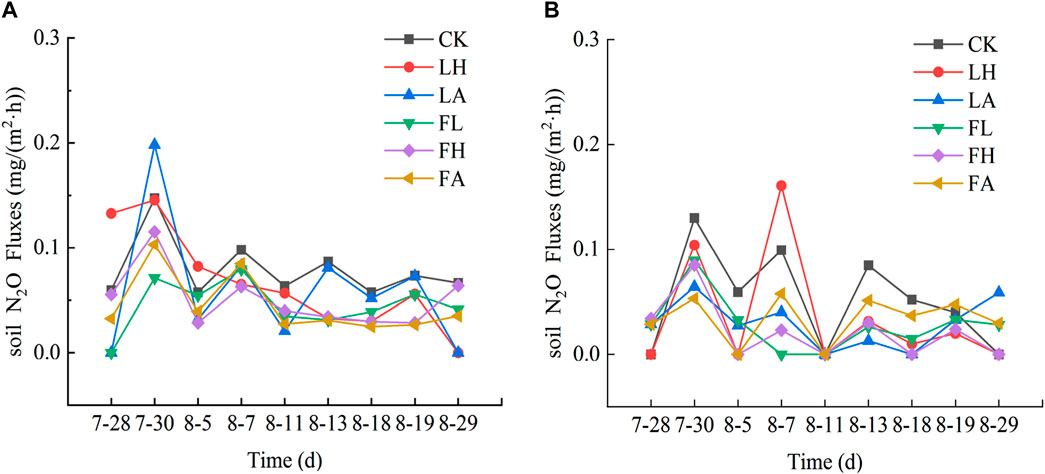
Figure 8. (A) Changes in soil N2O emission fluxes of cotton under different treatments (Note: a is soil N2O emission flux from cotton fields). (B) Changes in soil N2O emission fluxes of pepper under different treatments (Note: b is soil N2O emission flux from chilli peppers).
3.2.4 Effect of application of desulphurized gypsum and aeolian sand on cumulative emission fluxes of N2O from cotton-pepper soils
Calculation of cumulative soil N2O emission fluxes in cotton-pepper at fertility stage. The following results were obtained from Figure 9, the cumulative N2O emission fluxes of the treatments in the cotton field ranged from 0.3467 to 0.6179 kg/ha. Compared with the CK treatment, the LH, LA, FL, FH and FA treatments showed a reduction of 25.42%, 19.61%, 38.5%, 36.88% and 43.89%, respectively. Therefore, the cumulative soil emission fluxes of the different amendments were as follows: CK > LA > LH > FH > FL > FA.The cumulative N2O emission fluxes of chilli pepper treatments were in the range of 0.1633–0.4144 kg/ha. Compared with the CK treatment, the LH, LA, FL, FH, and FA treatments decreased by 33.47%, 39.96%, 43.39%, 60.59%, and 35.55%. Therefore, the cumulative soil emission fluxes of different amelioration measures were shown as CK > FA > LH > LA > FL > FH. Comparison of the cumulative emission fluxes of N2O from cotton and chilli among different treatments showed that the cumulative emission fluxes of soil N2O from all treatments in cotton field were higher than those from all treatments in chilli. Under the conditions of applying different amounts of desulfurization gypsum and aeolian sand, the cumulative soil CO2 emission fluxes of pepper treatments were 32.93%, 40.17%, 49.91%, 38.26%, 58.13% and 22.96% lower than those of cotton fields, respectively.
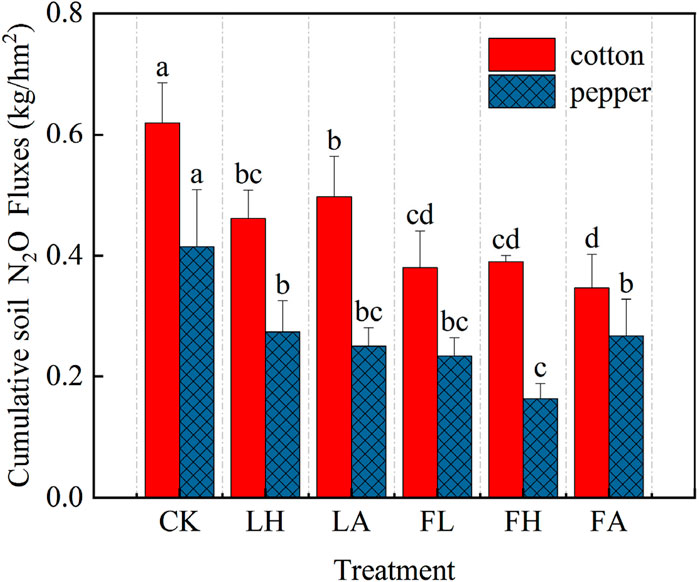
Figure 9. Changes in cumulative emission fluxes of N2O from cotton field and pepper soil under different treatments.
In summary, the cumulative soil N2O emission fluxes of both crops, cotton and chilli pepper, decreased gradually with the increase of FGD gypsum and sand application, and the cumulative soil N2O emission fluxes of all treatments in the cotton field were higher than those of all treatments in the chilli field, and the effects of the different amelioration measures on the cumulative soil N2O emission fluxes were significant.
3.3 Analysis of factors affecting greenhouse gas emission fluxes from FGD gypsum application and aeolian sand cotton-pepper soils
The correlation coefficients of CO2 and N2O cumulative emission fluxes and soil physicochemical properties of cotton-pepper soils under different treatments are shown in Table 2. Cotton field soil CO2 cumulative emission fluxes were significantly negatively correlated with 0–10 cm and 10–20 cm soil moisture, 0–10 cm and 20–40 cm electrical conductivity. Cotton field soil N2O cumulative emission flux was significantly positively correlated with 0–10 cm, 10–20 cm and 20–40 cm soil moisture, soil nitrate nitrogen and ammonium nitrogen, and 0–10 cm and 10–20 cm soil conductivity. The cumulative CO2 emission flux of chilli soil was significantly negatively correlated with soil moisture, and positively correlated with soil ammonium nitrogen. Cumulative N2O emission flux of chilli soil was significantly negatively correlated with soil moisture, soil nitrate nitrogen and soil conductivity.
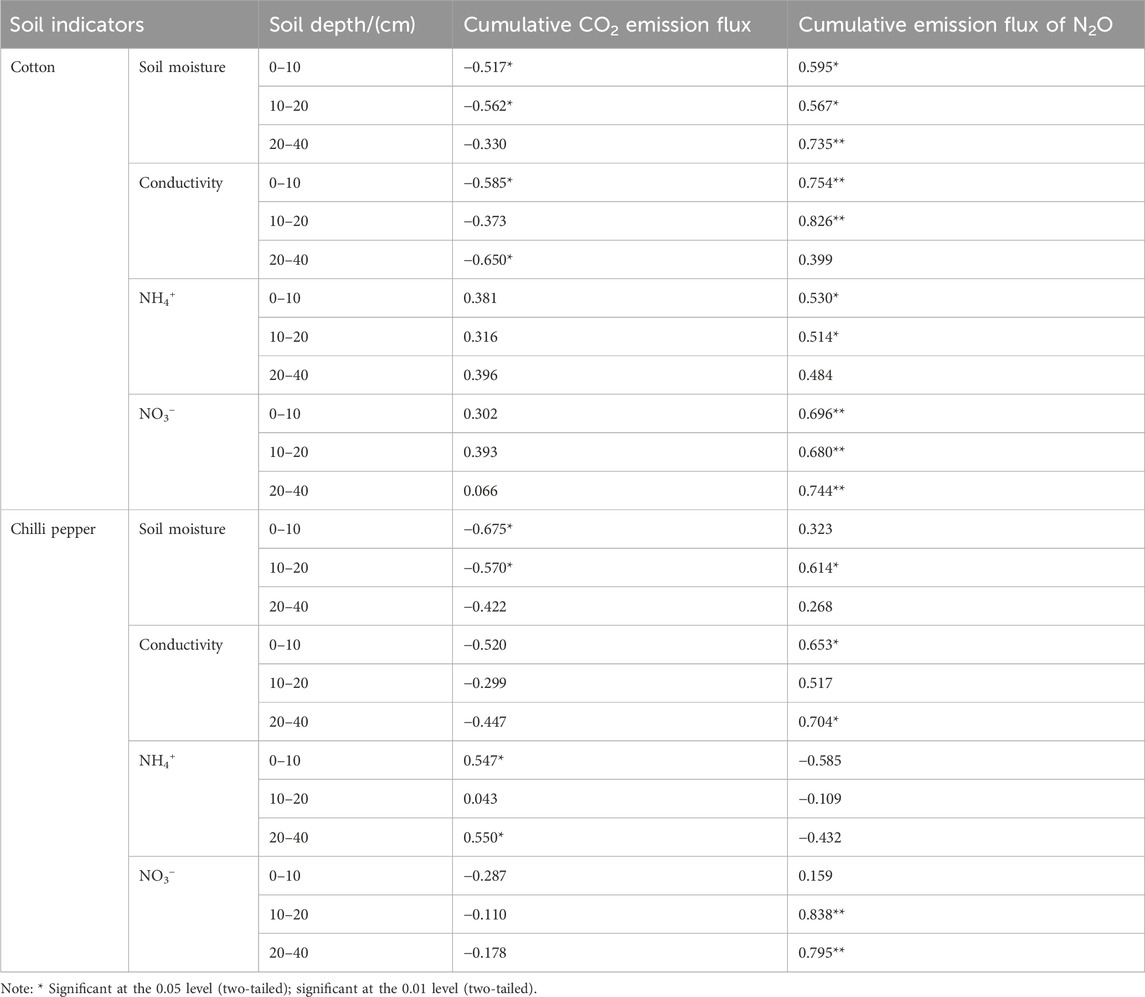
Table 2. Correlation between cumulative soil CO2 and N2O emission fluxes and soil physicochemical properties under different crops.
3.4 Effect of FGD gypsum and aeolian sand application on the combined greenhouse effect of cotton-pepper soils
The net warming potential and GHG emission intensity of cotton fields with different application rates of FGD gypsum and aeolian sand are shown in Table 3, and the combined warming potential (GWP) of the treatments at the centennial scale is positive, indicating a warming effect. On this basis, the data in Table 3 were evaluated, and the GWP of cotton field LH, LA, FL, FH and FA treatments varied from 3631.53 to 9045.19 kg/ha; compared with the control CK treatment, the treatments applying the improvement measures all reduced the GWP of the cotton field, with a reduction of 31.56%, 53.87%, 48.35%, 41% and 59.85%, respectively. The different treatments GWP in descending order were CK > LH > FH > FL > LA > FA. Carbon dioxide was the main contributor to the integrated warming potential of cotton fields, and its contribution to GWP ranged from 96% to 98%, while the variation of N2O’s contribution to GWP ranged from 0.0068% to 0.0119%. The GWP of chilli LH, LA, FL, FH and FA treatments varied from 2989.23 to 8083.83 kg/ha; all the treatments applying the improvement measures reduced the GWP of the cotton field by 35.98%, 58.91%, 42.57%, 44.25% and 63.02%, respectively, compared to the control CK treatment. The GWP of different treatments in descending order was CK > LH > FL > FH >> LA > FA. Carbon dioxide was the main contributor to the integrated warming potential of cotton fields, and its contribution to GWP ranged from 97% to 99%, while the variation of N2O’s contribution to GWP ranged from 0.0036% to 0.0089%.
4 Discussion
As the most active component of the carbon and nitrogen cycle in terrestrial ecosystems, greenhouse gas emissions from agricultural soils will certainly have a large impact on the carbon and nitrogen cycle at the regional and global scales (Yan, 2023). There are many factors affecting the emission of greenhouse gases from soils, and soil moisture, as one of the main factors affecting CO2 emission from soils, mainly affects the production and emission of greenhouse gases by influencing the physicochemical properties of soils, permeability, microbial activity and the rate of greenhouse gases diffusion from soils to the atmosphere (Li et al., 2007). In this experiment, the correlation of soil moisture on CO2 and N2O emissions from farmland showed that soil CO2 emission fluxes were significantly negatively correlated with soil moisture and soil N2O emissions were significantly positively correlated with soil moisture under the two crop cropping modes of cotton-chilli, so soil moisture was a significant factor influencing CO2 and N2O emission fluxes in this experiment. In addition to soil moisture, conductivity, nitrate nitrogen, ammonium nitrogen, and changes in soil structure by different amendment measures affected GHG emissions. In this experiment, the treatments suppressed greenhouse gas emissions to varying degrees under the conditions of applying different amounts of FGD gypsum and aeolian sand, as opposed to no amendment measures. The cumulative soil CO2 emissions of cotton and pepper crops showed a decreasing trend with the increase of the amount of desulphurized gypsum and aeolian sand, which was because the application of desulphurized gypsum increased the soil Ca2+ content, and a large amount of Ca2+ reacted with the CO2 produced by soil respiration to generate calcium carbonate precipitation, thereby reducing the soil CO2 emissions (He et al., 2017). Researches from Li (2023) and Xu et al. (2023) also showed that the larger the FGD gypsum addition, the more obvious the CO2 reduction effect, which is consistent with the results of this study.
Nitrification and denitrification are processes required for the conversion of N2O (Sun, 2022). Nitrification is the conversion of ammonium to nitrate and partially to N2O by microorganisms in the soil under soil aeration conditions. Among the main factors affecting soil GHG emissions, conductivity is one of the main factors. In this experiment, the cumulative emission fluxes of N2O were significantly and positively correlated with the conductivity, indicating that, with the increase of the conductivity, the cumulative emission fluxes of N2O increased with the increase of the conductivity. However, there is a critical value between salinity and N2O cumulative emission flux, and Zeng (2015) showed that in alkaline soil, salinity in the range of 5.52 ds/m would inhibit the nitrification reaction rate. The upper limit of soil conductivity in this experiment was 2,989 μs/cm, and with the increase of FGD gypsum application and the decrease of windblown sand application, the cumulative N2O emission gradually increased,but would be lower than the control treatment CK, which was in agreement with the above results, and also in agreement with the experimental results of Wang (2020); Dou (2020), and Ceng (2015) that the addition of FGD gypsum had an inhibitory effect on the emission fluxes of N2O, but in agreement with the Zhang (2023) test results in soda alkali soils in Northeast China: the application of FGD gypsum significantly reduces CH4 and CO2 emission fluxes and increases N2O emissions. The reason for the increase in soil conductivity is due to the increase in the amount of FGD gypsum applied, which is a salt as a by-product, and the newly generated salt ions are not completely eliminated due to environmental factors or insufficient irrigation water, thus leading to an increase in soil conductivity (Xu, 2023). At the same time, the level of nitrate and ammonium nitrogen in the soil, as inorganic nitrogen, can reflect the nitrogen supply of the soil (Liu et al., 2001). The addition of FGD gypsum and aeolian sand to the soil produces corresponding changes in the physical structure of the soil, and with the increase in the amount of FGD gypsum and WDS applied, the soil bulk density decreases and the porosity increases, which is conducive to the absorption of nitrogen. In this experiment, with the increase of FGD gypsum application, NH4+ gradually decreased and NO3− gradually increased in cotton field soil, indicating that soil microorganisms converted ammonium salts into nitrates and promoted the aeolian nitrification process, whereas chilli pepper crop promoted the nitrification process in the aeolian sand treatment; with the increase of aeolian sand application, NH4+ gradually increased and NO3− gradually decreased in cotton field soil, indicating that the aeolian sand treatment inhibited the nitrification process of ammonia and oxygen in the aeolian sand treatment, Nitrification process was inhibited and nitrogen uptake was promoted. The correlation between NH4+, NO3− and N2O emissions showed that after the application of different improvement measures, the ammonium nitrogen content of cotton soil gradually increased and the nitrate nitrogen content of soil gradually decreased with the increase of the application of aeolian sand; and with the increase of FGD gypsum dosage, the ammonium nitrogen content of chilli soil gradually increased and the nitrate nitrogen content of soil gradually decreased, and the overall presentation of the cumulative emissions of soil N2O. It was significantly positively correlated with conductivity and nitrate nitrogen, and significantly negatively correlated with ammonium nitrogen, and the results of the study were similar to those of Sun (2014).
5 Conclusion
1) During the monitoring period, cotton and pepper were planted. Compared with CK, LA had the best water retention effect and FA had the best water retention and salt reduction effect. 2) Compared with CK, FA treatment significantly inhibited soil cumulative greenhouse gas emission fluxes, and reduced the comprehensive greenhouse effect of cotton fields and pepper crops by inhibiting soil CO2 emission fluxes. 3) Through comprehensive analysis, it is reasonable to apply FA treatment to saline-alkali soil, which can better achieve the effect of water preservation, salt reduction and emission reduction.
Data availability statement
The raw data supporting the conclusions of this article will be made available by the authors, without undue reservation.
Author contributions
YC: Conceptualization, Data curation, Formal Analysis, Investigation, Methodology, Project administration, Software, Writing–original draft, Writing–review and editing. FL: Writing–original draft, Writing–review and editing. YG: Writing–original draft, Writing–review and editing. XH: Writing–original draft, Writing–review and editing. JW: Writing–original draft, Writing–review and editing. DF: Writing–original draft, Writing–review and editing. RG: Writing–original draft, Writing–review and editing.
Funding
The author(s) declare that financial support was received for the research, authorship, and/or publication of this article. XPCC Southern Xinjiang Key Industries Innovation and Development Support Project (2021DB017); Joint Foundation of Tarim University, Agricultural University of China (2019TC157).
Acknowledgments
We are thankful to Weixiong Huang (orcid.org/0000-0002-1704-5550) for his help in English editing for the paper.
Conflict of interest
The authors declare that the research was conducted in the absence of any commercial or financial relationships that could be construed as a potential conflict of interest.
Publisher’s note
All claims expressed in this article are solely those of the authors and do not necessarily represent those of their affiliated organizations, or those of the publisher, the editors and the reviewers. Any product that may be evaluated in this article, or claim that may be made by its manufacturer, is not guaranteed or endorsed by the publisher.
References
Ceng, D. P. (2015). The effect of exotic matters amendments on greenhouse gases emmision in Fuzhou paddy fields. Master. Fujian Normal University. Available at: https://kns.cnki.net/kcms2/article/abstract?v=29axctaKF3wx0ojCaNf3spZnt4o-0tu5PGWrmEOUiXcrXFYK4YF1L2v3XYEPkVAuUcUnNQgV6UPQs8vw66_j1jYG9afRqEHHI21THD0Hglk1T12iMgOX0flPPNdcycSobYnObqW5N73RgPBvL_Vb1g==&uniplatform=NZKPT&language=CHS.
Chen, X. L. (2023). Effects of biochar on water and solute migration in coastal saline-alkali soil Master's Degree. Zhejiang Univ. Sci. Technol. doi:10.27840/d.cnki.gzjkj.2023.000064
Dou, Y. Y. (2020). Effects of mixed application of desulfurized gypsum and biochar on N2O emissions from paddy fields. Master. Southwest University. doi:10.27684/d.cnki.gxndx.2020.004601
Guo, Y. F., Zhang, L. P., Wang, G. S., Shang, R. C., Zhang, H., Zhu, Z. H., et al. (2022). Effects of the tillage and combination of water and fertilizer on the greenhouse gas emissions of wheat-maize field. Chin. J. Agric. Eng. (13), 95–104.
He, K., Li, X. P., Zhou, C. L., Zhou, J., Dong, L. L., and Mao, Y. M. (2017). Influence of flue gas desulfurization gypsum on speciation of phosphorus in coastal cultivated soils. Acta Ecol. Sin. 37 (09), 2935–2942. doi:10.5846/stxb201601170111
Huang, J. Y., Yu, H. L., Zhang, J. H., Sun, Z. J., and He, W. S. (2011). Effects of flue gas desulfurization gypsum and krilium application on alkali soil amelioration. Soil Bull. (6), 1467–1471. doi:10.19336/j.cnki.trtb.2011.06.034
Jiang, Z. B., Ning, S. R., and Wang, Q. J. (2023). A comprehensive evaluation of the effect of desulfurized gypsum for improving saline-alkali soil. J. Soil, 1–18. Available at: http://kns.cnki.net/kcms/detail/32.1119.p.20231023.1618.004.html.
Kiehl, J. T., and Trenberth, K. E. (1997). Earth's annual global mean energy budget. Bull. Amer. Meteor. Soc. 78 (2), 197–208. doi:10.1175/1520-0477(1997)078<0197:EAGMEB>2.0.CO;2
Li, H. F., Xia, H. P., Xiong, Y. M., and Zhang, X. F. (2007). Mechanism of greenhouse gases fluxes from soil and its controlling factors: a review. Ecol. Environ. (6), 1781–1788. doi:10.16258/j.cnki.1674-5906.2007.06.027
Li, H. W. (2023). Effects of desulfurization gypsum and wind-bound sand in improving soil and controling CO2 emission in saline cotton field. Master. Tarim. Univ. doi:10.27708/d.cnki.gtlmd.2023.000156
Li, J. G., Pu, L. J., Han, M. F., Zhu, M., Zhang, R. S., and Xiang, Y. Z. (2014). Soil salinization research in China: advances and prospects. J. Geogr. Engl. 24 (5), 943–960. doi:10.1007/s11442-014-1130-2
Liu, C. L., Zhou, Z. D., Wang, H. K., and Xue, J. H. (2023). Effects of microplastics on soil physicochemical properties and functional microorganisms related to nitrogen cycling. J. Environ. Sci. (08), 396–406. doi:10.13671/j.hjkxxb.2023.0029
Liu, X. H., Hao, M. D., and Tian, M. X. (2001). Contribution of soil mineral nitrogen and soil mineralization nitrogen to seasonal crop. Soil Environ. (03), 207–209.
Shao, X. H., Tang, S. R., Meng, L., Wu, Y. Z., Li, J. Q., and Gou, G. L. (2022). Effect of different fertilization treatments on methane and nitrous oxide emissions from rice-vegetable rotation in a tropical region, China. Environ. Sci. 43 (11), 5149–5158. doi:10.13227/j.hjkx.202112213
Shi, X. H., Zhang, X. P., Liang, A. Z., Shen, Y., Fan, R. Q., and Yang, X. M. (2010). Advance in the main factors controlling soil carbon dioxide flux. Soil Bull. (03), 761–768. doi:10.19336/j.cnki.trtb.2010.03.049
Sun, L. B. (2022). Mechanism of microbially driven nitrous oxids production in agricultural soils of Northern China. Master's Degree thesis. Jilin Jianzhu University. doi:10.27714/d.cnki.gjljs.2022.000208
Sun, X. (2014). Effect of salinity, pH、Nitrogen ferilizer on saline alkali soil N2O emission. Master. Inn. Mong. Norm. Univ. Available at: https://kns.cnki.net/kcms2/article/abstract?v=29axctaKF3yPZJ6fXpnBM5Y0QsoikbwfCEQu6E85aLx-x9pF01oFTH244tRKf7MJLq-QdO77-nVZqfBVP9LucrpbwPs0rcyFpF_pKLQM0pAPzQuNEpzbp6AYrEyR57bwEAI8wTNph8QSnSo0b4swig==&uniplatform=NZKPT&language=CHS.
Tong, Y. S., Zhang, C. P., Dong, Q. M., Yu, Z. H., Yang, Z. Z., Zhang, X. F., et al. (2024). The effects of nitrogen forms on biomass allocation and leaf photosynthetic characteristics of dominant species in alpine artificial grassland plant communities. Ecology, 1–11. Available at: http://kns.cnki.net/kcms/detail/21.1148.q.20240318.1728.011.html.
Wang, F. (2020). Response of greenhouse gases emissions and net greenhouse effect to nutrient management in purple soil. PhD Dissertation. Southwest University. doi:10.27684/d.cnki.gxndx.2020.005571
Wang, X. Y., Cai, H. J., Li, L., Xu, J. T., and Chen, H. (2019). Effects of water deficit on greenhouse gas emission in wheat field in different periods. Environ. Sci. 40 (5), 2413–2425. doi:10.13227/j.hjkx.201808075
Wei, C. C., Ren, S. M., Xu, Z. A., Zhang, M. T., Wei, R., and Yang, P. L. (2021). Effects of irrigation water salinity and irrigation water amount on greenhouse gas emissions and spring maize growth. Chin. J. Agric. Mach. (07), 251–260+236.
Xiang, Q. J. (2018). Effects of sulfur-containing industrial by-products on greenhouse gases emissions from yellow paddy fields. Master's Degree. Southwest University. Available at: https://kns.cnki.net/kcms2/article/abstract?v=29axctaKF3xRz7GUAqqVaj4nrrTygH_iWFWfeM4u5SQuLow7knawWgbSXaCJbHcEvHsD0VjkdT5DsPwnJ9ZCRtKn_W3cTI8SkK1viJ85VVHzAaj3iCfMkSCAtkpmPPLgLHmC3u6dO-Hof5TR4p4y3w==&uniplatform=NZKPT&language=CHS.
Xu, X. (2023). Improvement and safety evaluation of phosphogypsum-based soil amendment in mintigating soil salinity stress. Master. Beijing University of Chemical Technology. doi:10.26939/d.cnki.gbhgu.2023.000492
Xu, Y., Luo, M. L., Mu, Z. J., Lei, Y., Shan, Q. L., Liu, S. P., et al. (2023). Effects of mixed application of biochar and desulfurized gypsum on carbon emission in paddy field. J. Agric. Environ. Sci. (11), 2614–2624.
Yan, Q. (2023). Modelling greenhouse gas emissions of maize farmland under climate change using DayCent. Master's thesis. Northwest A&F University. doi:10.27409/d.cnki.gxbnu.2023.002321
Yin, Q. R. (2011). Effects of salinization on physical and hydrodynamics characteristics. Master's Degree. Northwest A&F University. Available at: https://kns.cnki.net/kcms2/article/abstract?v=29axctaKF3yoV2gFkxMLtWTFxd8UfaIm7YIxkyQ6-iFbd-6pDdntx_2owJV5tbDg7mJYiLpNOaRLtCfnxK9yVliBHnVwRX1iiIViOsCuWYGNrRWLAaKiVi-LAKNSNCypUvJVcqjzbrqxuCy2-1US9w==&uniplatform=NZKPT&language=CHS.
Zeng, W. Z. (2015). Research and simulation for the coupling effects of water, nitrogen, and salt on sunflower. Ph.D. Dissertation. Wuhan University. Available at: https://kns.cnki.net/kcms2/article/abstract?v=29axctaKF3yqZIsUA2A3DEjJSLMpjHSpOiq9tevC46yHD2erdUIh9RL2Uk53nDVc5Y2fGjG_715tIYft7FYzoWrk_cpmao4ZCkRbWWDDmKZesf3848IRwIc27yJ-q4aeuG36jTlbPL63Yc7PNi_uhA==&uniplatform=NZKPT&language=CHS.
Zhang, F. M. (2023). Study on the effects of different amendments on ammonia volatilization and greenhouse gas emissions from soda-saline rice paddy fields. Master. Northeast Normal University. doi:10.27011/d.cnki.gdbsu.2023.001613
Zhang, G. B., Ma, J., Xu, H., and Yan, X. Y. (2023). Status quo of research and suggestions on reduction of non-CO2 greenhouse gas emission from Chinese farmland. Proc. Chin. Acad. Sci. (03), 504–517. doi:10.16418/j.issn.1000-3045.20211112001
Zhang, Y. (2019). Research on the effects of Different Amendments and irrigation methods on Saline-alkali land Improvement and greenhouse gas emission. Master's thesis. Inn. Mong. Agric. Univ. doi:10.27229/d.cnki.gnmnu.2019.000327
Keywords: salinized soil, desulfurized gypsum, aeolian sand, soil CO2 and N2O emission fluxes, comprehensive greenhouse effect salinized soil, comprehensive greenhouse effect
Citation: Chen Y, Luo F, Guan Y, He X, Wang J, Fan D and Gao R (2024) Influence of different application rates of FGD gypsum and aeolian sand on CO2 and N2O emissions from cotton-capsicum saline-alkali soil. Front. Environ. Sci. 12:1431068. doi: 10.3389/fenvs.2024.1431068
Received: 13 May 2024; Accepted: 08 August 2024;
Published: 20 September 2024.
Edited by:
Jing Liu, University of Birmingham, United KingdomReviewed by:
Peiling Yang, China Agricultural University, ChinaChenchen Wei, Changjiang River Scientific Research Institute (CRSRI), China
Copyright © 2024 Chen, Luo, Guan, He, Wang, Fan and Gao. This is an open-access article distributed under the terms of the Creative Commons Attribution License (CC BY). The use, distribution or reproduction in other forums is permitted, provided the original author(s) and the copyright owner(s) are credited and that the original publication in this journal is cited, in accordance with accepted academic practice. No use, distribution or reproduction is permitted which does not comply with these terms.
*Correspondence: Yao Guan, NDE3NTEyNjc2QHFxLmNvbQ==; Xinghong He, aGV4aW5naG9uZzA2MTFAMTYzLmNvbQ==
 Yiwei Chen
Yiwei Chen Fan Luo
Fan Luo Yao Guan
Yao Guan
